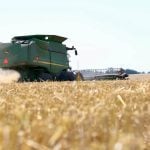Q: When and how should I scout for cutworms?
A: With a new growing season upon us, growers must keep a watchful eye for pests in their fields. One early-season pest is cutworms.
Cutworms have a ferocious appetite for young developing plants. They can be a problem in many western Canadian crops but canola is most susceptible to damage. The advent of new insecticide treatments provides a preventive measure but growers should still scout for this pest.
Read Also

Claas brings 1000 Series SP forage harvesters to Canada
In mid-August, Claas unveiled its new line of Jaguar forage harvesters at an event in Visalia, California, deep in the heart of that state’s dairy region.
About seven different cutworm species cause problems on the Prairies. The redbacked cutworm (located in northern areas) and the pale western cutworm (more dominant in the southern part of the Prairies) contribute to a large portion of economic loss from year to year. However, damage from black, glassy, dingy and bristly cutworms can also occur in localized areas.
Scout for cutworms from May to July. Look for wilted and severed plants or plants that have notched leaves or leaves with holes. In cereals, there can be severed leaves or leaves removed by the stem. Damage tends to move along the seed row, with patches developing over time. Scout the edge of bare areas to find worms. Cutworms move to areas where food is available. Take a small shovel and dig the top one to two inches (or even deeper in some conditions) around the base of severed plants and look for larva. When larvae are disturbed they curl up, a characteristic of most cutworm species.
Redbacked larva have a reddish-brown stripe down the back with a dark centre line bordered by a dark band on each side. Pale western cutworms are pale grey to greenish grey in colour. They have no striping and the head is a yellowish brown. Cutworms are more active at night, but can be scouted for during the day.
Cutworm outbreaks are influenced by several factors, weather being the most important. However, predicting an outbreak is very difficult so regular crop scouting is required to identify potential issues.















